Ever wonder why your family and community celebrate certain events when they do? Or where the holidays you’ve taken for granted since you were a kid even come from? Traditions evolve over generations and can be visible or subtle clues into your family heritage.
Irish holidays and traditions are windows into our family history. Many are a combination of Celtic and Catholic traditions as well as a result of Ireland’s political, cultural, and social struggles – especially the oppression of the Catholics (by the English).

Irish Holiday Traditions – Christmas
As a majority of the Irish population identified as Catholic, a common Catholic thread runs through many of the Irish holidays and traditions.
The Candle in the Window
One of the most common Irish holiday traditions is the candle in the window. In Penal times, Irish Catholics would light a candle and place it in a window to be visible to passers-by. The candle was code for Catholics so that people knew they could expect a covert Mass in the household.
After a resurgence of popularity in the 1970s, this tradition is now less popular than it once was. The candle in the window has resumed its original meaning, acting as a guiding light for those seeking shelter, especially the itinerant poor, just as Mary and Joseph once searched for lodgings.
The Laden Table
Also set aside for Mary and Joseph is a simple meal, left out after dinner on Christmas Eve. Presented alongside milk, a loaf of bread baked with raisins and caraway seeds is a staple of this Irish Catholic tradition.
Holly
One of the most common Irish holiday traditions is using a wreath of holly to decorate during the Christmas season. As a population forced into poverty by English rule, the Irish didn’t have much for holiday decorations. The holly plant was one of the few that grew in the colder season, giving the poor masses something to dress up their homes.
Saint Stephen’s Day
Holly is also used in the Wren Boy Procession that happens on Saint Stephen’s Day, known as Boxing Day outside of Ireland. The Irish tradition goes back to Penal times. Legend has it, a flock of wrens interrupted an ambush that Irish rebels had organized to overthrow the English. A wren, or “Devil’s Bird,” used to be sacrificed to commemorate the species’ betrayal. (Note: there are other origins of Wren Day.)
Today, people prefer to dress up as the bird in straw outfits or old clothes, bringing holly from house to house on the day after Christmas. The practice of visiting friends is also common on Saint Stephen’s Day.
Irish Christmas Tradition Fun Facts:
- It’s considered bad luck to take down the tree or holiday decorations before January 6th, which is commonly known as “Little Christmas”
- “Merry Christmas” in Gaelic is “Nollaig Shona Duit”
Christmas is a great time to learn more about your Irish ancestry with your family. Share and record stories of relatives and find new stories about your ancestors in Irish-American newspapers.
Other Irish Holidays & Traditions
In addition to the above Irish Christmas traditions, learn more about the Irish origins of these popular holiday traditions that your Irish ancestors brought with them to America.
Halloween or All Hallows Eve
The ultimate example of the marriage of pagan and Catholic rites, Halloween is linked to the Celtic Samhain, a celebration that marked the end of the harvest, or life-giving season. What followed was its opposite: the death-giving season of winter that began November 1st. People would dress up and light enormous bonfires to ward off ghosts that were believed to travel on the night before, October 31st, deemed something of a portal between the worlds of life and death.
Originally known as All Hallows Eve, the name was changed with Christianity’s arrival in Ireland. The tradition of Halloween traveled with Irish immigrants to America and has become a secular and heavily commercialized holiday around the world. Costumes and fires, albeit tamed and reduced to fit into jack-o-lanterns, live on to this day.
Halloween also hosts two of the most common Irish holiday food traditions. Colcannon is made with potato and cabbage, while Barmbrack is a bready cake with raisins. Both dishes hide a charm or ring within that the lucky will find in their plates.
Saint Patrick’s Day
Saint Patrick was originally celebrated for bringing Christianity to Ireland. However, today Saint Patrick’s Day is primarily associated with drinking and wearing green. But before critics condemn the practice too harshly, it should be known that there is a historical link to consuming alcohol on the day. Christian practitioners were allowed to suspend the observances of Lent to celebrate their patron saint’s day.
While some Irish traditions such as St. Patrick’s Day are well known worldwide, many people may not know the Irish origins of other common traditions, such as Halloween. What Irish traditions exist in your family’s holiday celebrations? Share your family traditions in the comments section below.
Sources
- Encyclopedia Britannica. “Penal Laws” retrieved from https://www.britannica.com/event/Penal-Laws
- Ireland Information. “Irish Christmas Traditions” retrieved from http://www.ireland-information.com/articles/irishchristmastraditions.htm

This is really awesome for me because I’m doing an Irish culture page and I’m very excited to finish. It will be great thanks to you.
P.S I’m Irish.
That’s wonderful, Isabella; we’re glad our article is helping you with your Irish culture page!